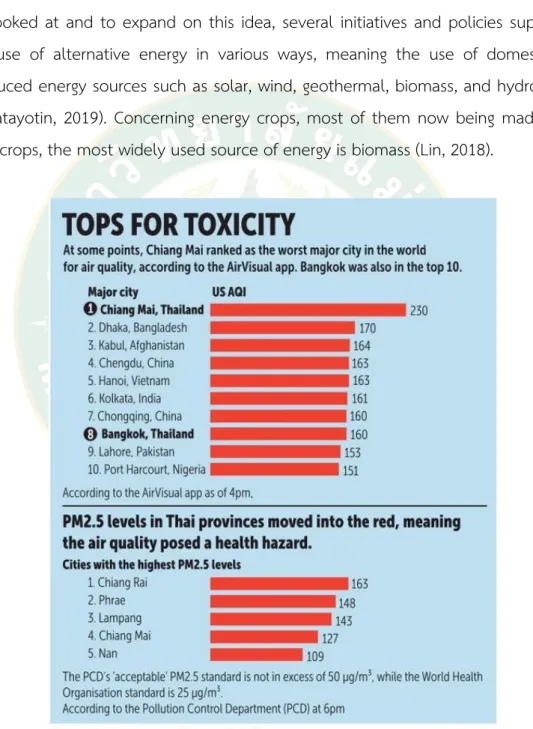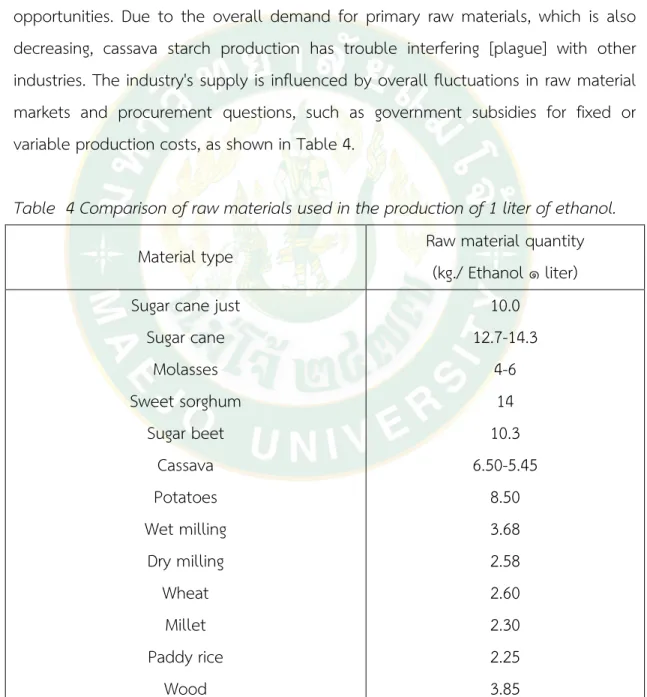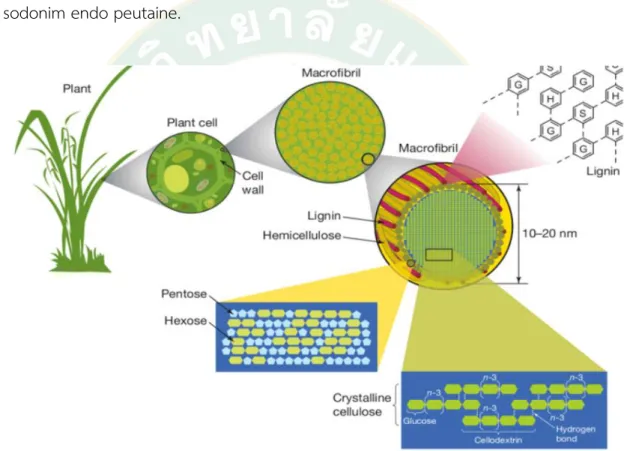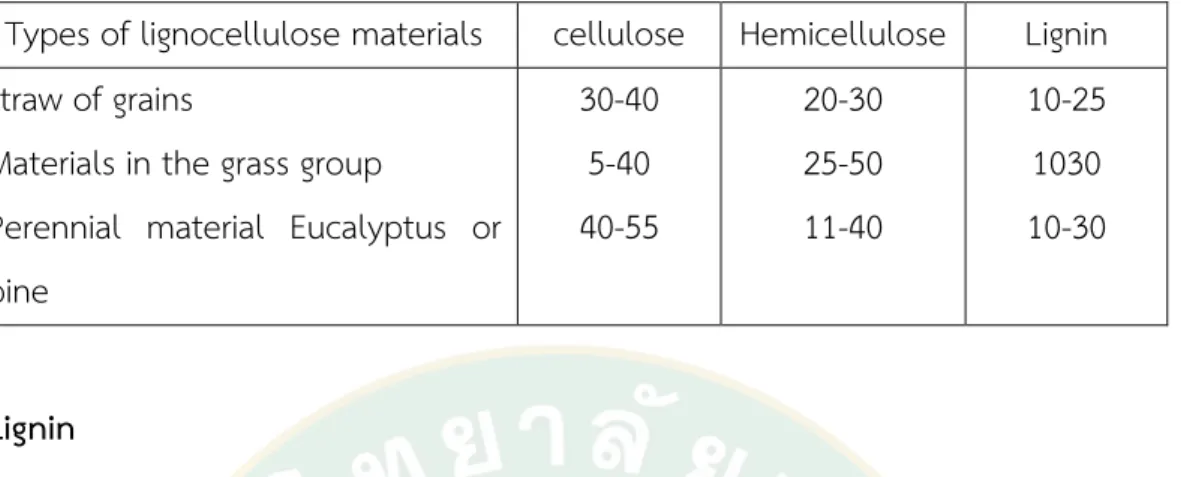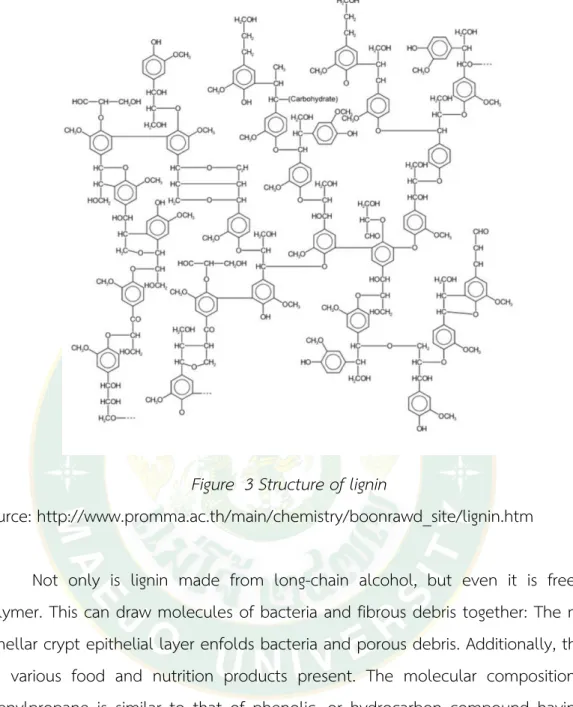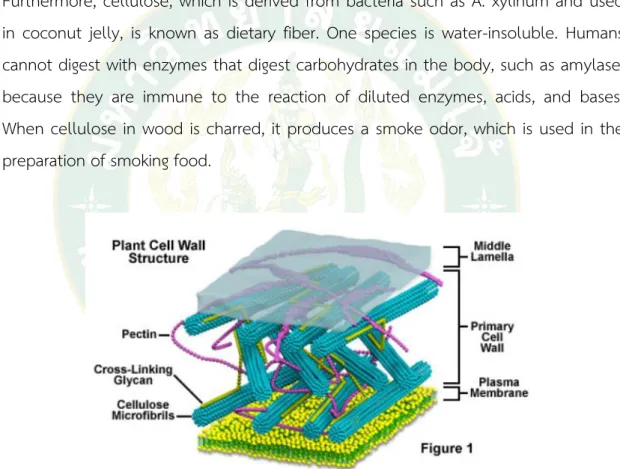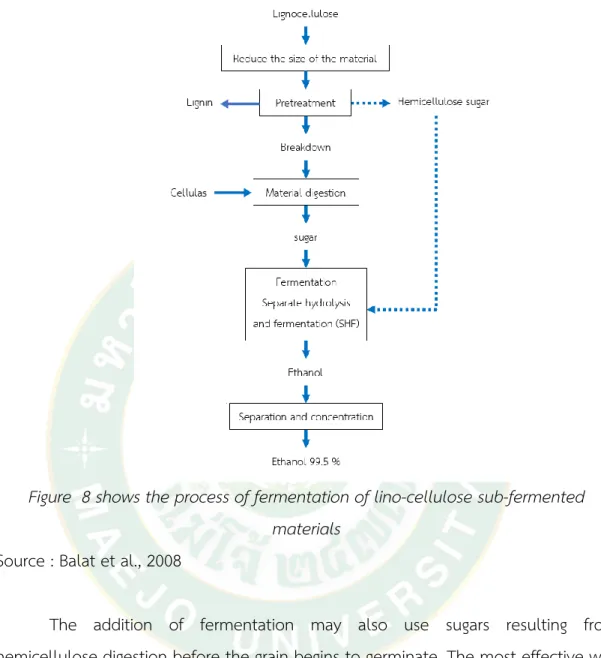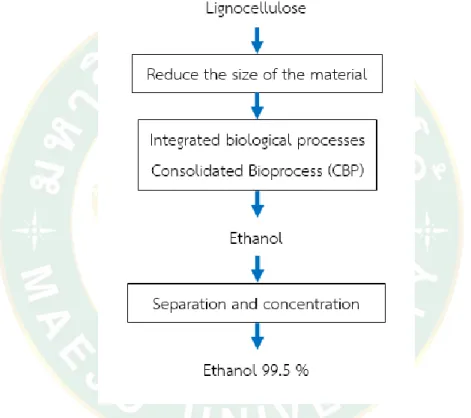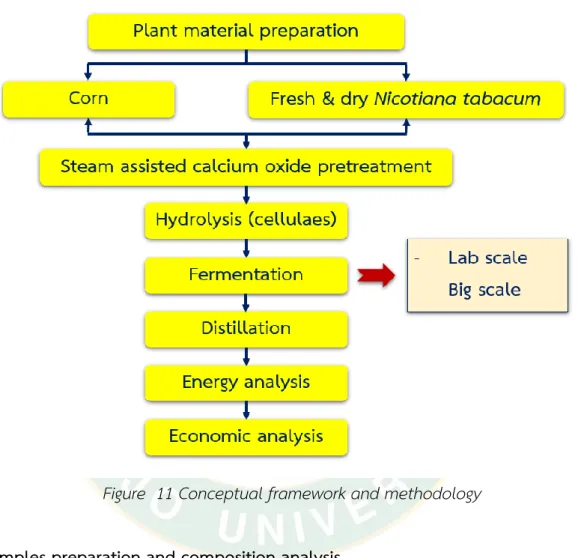FEASIBILITY ASSESSMENT OF
BIOETHANOL FROM ZEA MAYS AND NICOTIANA TABACUM STALKS
KARN SOPHANODORN
MASTER OF ENGINEERING IN RENEWABLE ENERGY ENGINEERING MAEJO UNIVERSITY
2021
FEASIBILITY ASSESSMENT OF
BIOETHANOL FROM ZEA MAYS AND NICOTIANA TABACUM STALKS
KARN SOPHANODORN
A THESIS SUBMITTED IN PARTIAL FULFILLMENT
OF THE REQUIREMENTS FOR THE DEGREE OF MASTER OF ENGINEERING IN RENEWABLE ENERGY ENGINEERING
ACADEMIC ADMINISTRATION AND DEVELOPMENT MAEJO UNIVERSITY 2021
Copyright of Maejo University
3
FEASIBILITY ASSESSMENT OF
BIOETHANOL FROM ZEA MAYS AND NICOTIANA TABACUM STALKS
KARN SOPHANODORN
THIS THESIS HAS BEEN APPROVED IN PARTIAL FULFLLMENT OF THE REQUIREMENTS FOR THE DEGREE OF MASTER OF ENGINEERING
IN RENEWABLE ENERGY ENGINEERING
APPROVED BY Advisory Committee
Chair
(Dr. Rameshprabu Ramaraj)
.../.../ ...
Committee
(Assistant Professor Dr. Nigran Homdoung)
.../.../ ...
Committee
(Assistant Professor Dr. Yuwalee Unpaprom)
.../.../ ...
Program Chair, Master of Engineering
in Renewable Energy Engineering (Assistant Professor Dr. Tanate Chaichana)
.../.../ ...
CERTIFIED BY ACADEMIC
ADMINISTRATION AND DEVELOPMENT
(Associate Professor Dr. Yanin Opatpatanakit) Vice President for the Acting President of Maejo
University
.../.../ ...
C
ABSTRACT (THAI)
ชื่อเรื่อง การประเมินความเป็นไปได้ในการผลิตไบโอเอทานอลจากต้นข้าวโพดและ
ยาสูบ
ชื่อผู้เขียน ว่าที่ร้อยโทกาณฑ์ โสภโณดร
ชื่อปริญญา วิศวกรรมศาสตรมหาบัณฑิต สาขาวิชาวิศวกรรมพลังงานทดแทน
อาจารย์ที่ปรึกษาหลัก Dr. Rameshprabu Ramaraj
บทคัดย่อ
กรณีเกี่ยวกับการเปลี่ยนเชื้อเพลิงฟอสซิล วัสดุจากป่า และวัสดุอื่น ๆ ให้กลายเป็น วัตถุดิบ เช่น แป้งและแหล่งวัตถุดิบอื่น อันเนื่องมาจากมาจากจำนวนประชากรที่เพิ่มขึ้น และต้องการ ผลิตเชื้อเพลิงพลังงานทดแทน วัสดุเหลือทิ้งจากต้นยาสูบและต้นข้าวโพดอาหารสัตว์ปริมาณหนึ่งตัน สามารถใช้เป็นวัตถุดิบในการแปรรูปเป็นเชื้อเพลิงได้ ดังนั้นจึงนำต้นยาสูบและต้นข้าวโพดอาหารสัตว์
ใช้ในการทดลองนี้เพื่อผลิตไบโอเอทานอล ในต้นพืชมีส่วนประกอบทางเคมีจำนวนมาก ได้แก่
เซลลูโลส เฮมิเซลลูโลส และลิกนิน ตามลำดับ และใช้วิธีฟีนอล – ซัลฟิวริก และ DNS วิเคราะห์
น้ำตาลทั้งหมดและน้ำตาลรีดิวซ์เพื่อตรวจสอบน้ำตาลที่ได้ก่อนและหลังกระบวนการหมักไบโอเอทา นอล นอกจากนี้ยังได้ใช้วิธีปรับสภาพร่วมให้ชีวมวลสามารถเปลี่ยนเป็นน้ำตาลให้มากขึ้นเพื่อเพื่อ ผลผลิตไบโอเอทานอล ซึ่งได้เลือกวิธีการที่ได้น้ำตาลสูงที่สุดในการทำไฮโดรไลซิสและหมักไบโอเอทา นอล น้ำตาลทั้งหมดและน้ำตาลรีดิวซ์ของต้นยาสูบที่ได้จากผลการทดลองคือ 27.97 กรัม / ลิตรและ 5.43 กรัม / ลิตร ผลการทดลองพบว่าที่ 48 ชั่วโมงของการหมัก ผลผลิตเอทานอลสูงสุดที่ 75.74 กรัม / ลิตร ในศึกษานี้มีวัตถุประสงค์ในการประเมินการผลิตไบโอเอทานอล โดยใช้วัตถุดิบที่มีต้นทุน ต่ำ ได้แก่ ต้นยาสูบหลังการเก็บเกี่ยวใบ ในขณะเดียวกันต้นข้าวโพดอาหารสัตว์ก็มีลักษณะดังกล่าว ซึ่ง พบวความเข้มข้นของน้ำตาลสูงสุดหลังกระบวนการไฮโดรไลซิส น้ำตาลทั้งหมดและน้ำตาลรีดิวซ์ของ ต้นข้าวโพดมีค่าเท่ากับ 191.667 กรัม / ลิตร และ 84.625 กรัม / ลิตร ผลการทดลองพบว่าที่ 120 ชั่วโมงของการหมักซึ่งได้ผลผลิตเอทานอลสูงสุดคือ 158.59 กรัม / ลิตร การใช้ต้นยาสูบเหลือทิ้ง เป็น แนวทางเปลี่ยนพืชผลทางการเกษตรที่เหลือทิ้งเป็นแหล่งชีวมวลที่สำคัญสำหรับอุตสาหกรรมปิโตรเคมี
เพื่อผลิตไบโอเอทานอลในราคาที่เหมาะสม กระบวนการแยกไฮโดรไลซิสและการหมัก (SHF) การ ผลิตเอทานอลด้วยถังหมักระบบคอมพิวเตอร์ถูกนำมาใช้ในกระบวนการหมักชีวมวลของต้นยาสูบและ ข้าวโพดสายพันธุ์ดั้งเดิมของไทย โดยลำต้นถูกย่อยหลังจากปรับสภาพด้วยวิธีทางกายภาพ / เคมีที่มี
ประสิทธิภาพสูงที่สุด ในการปรับสภาพได้ใช้สารเคมีอัลคาไลน์ที่มีต้นทุนต่ำที่สุด (แคลเซีมออกไซด์
2%) และในการหมักเอทานอลได้ใช้จุลิทรีย์ที่ใช้สำหรับการผลิตเอทานอลทางอุตสาหกรรม คือ
D Saccharomyces cerevisiae จากการศึกษาในครั้งนี้ แสดงให้เห็นว่า การปรับสภาพชีวมวลด้วยวิธี
ทางกายภาพ / เคมี และการใช้เอนไซม์ในการไฮโดรไลซิส มีส่วนช่วยทำให้ผลผลิตเอทานอลจากต้น ยาสูบและต้นข้าวโพดสูงขึ้น อย่างไรก็ตามในการขยายขนาดการผลิตไบโอเอทานอลจากทั้งต้นยาสูบ ทั้งต้นและต้นข้าวโพดอาหารสัตว์ยังคงต้องมีการทำวิจัยเพิ่มขึ้น และเป็นความท้าทายในการศึกษา ต่อไป
คำสำคัญ : ไบโอเอทานอล, ต้นยาสูบ, ต้นข้าวโพดอาหารสัตว์, RSM
D
ABSTRACT (ENGLISH)
Title FEASIBILITY ASSESSMENT OF
BIOETHANOL FROM ZEA MAYS AND NICOTIANA TABACUM STALKS
Author SUB LIEUTENANT Karn Sophanodorn
Degree Master of Engineering in Renewable Energy
Engineering
Advisory Committee Chairperson Dr. Rameshprabu Ramaraj
ABSTRACT
Extending the debate about removing fossil fuels, forest and field materials, and other materials into things like starches and conventional sources inevitably increases the number of people who want to produce renewable fuels.
One ton of different bio-refinery waste streaming can be used as cultivated tobacco stalk and animal corn stalks. Hence, tobacco stalks and animal corn stalks were used in this experiment to create bio-ethanol. The stalks contain huge chemical compounds, including cellulose, hemicellulose and lignin, respectively. The total and reducing sugar utilizing phenol-sulfuric and DNS methods were used to confirm before and after the bioethanol fermentation process. Furthermore, it was incorporated into the collective pretreatments to significantly affect biomass and more accessibility to available sugars to improve bioethanol yield. Proceed with the bioethanol fermentation with the highest sugar concentration and separate the product using hydrolysis. The total and reducing sugar levels of tobacco stalks were obtained from experimental results of 27.97 g/L and 5.43 g/L. The results indicated that at 48 hours of fermentation, the maximum ethanol yields were 75.74 (g/L). In this report, an attempt has been made to investigate bioethanol production using low-cost feedstock, namely after leaf harvest tobacco waste. In a similar study using animal corn stalks, it was found that the highest sugar concentration after hydrolysis process. The total sugar and reducing sugar levels of the corn stalks were obtained from the experimental results of 191.667 g/l and 84.625 g/l. The results showed that
E at 120 hours of fermentation which achived the highest ethanol yield was 158.59 g/L.
The use of a plant's tobacco stalk residue will turn a leftover agricultural crop, a significant source of biomass for the petrochemical industry, into an affordable supply of bioethanol. Separate hydrolysis and fermentation (SHF) in ethanol production with a computerized fermenter were used in the biomass process with traditional Thai tobacco and corn. The stalks were successfully hydrolyzed due to the use of an efficient physical/chemical pretreatment. Since it was the least costly alkaline chemical (2% CaO), it was used for pretreatment. The best choice for industrial ethanol production was Saccharomyces cerevisiae, which was chosen for the project. These findings support the hypothesis that biomass pretreatment would allow ethanol from animal starch and corn stalk via both physical and enzymatic hydrolysis. While the expansion of bioethanol production using whole tobacco and animal corn stalks is a potentially positive aspect still being studied, some challenges must be addressed.
Keywords : Bioethanol, Tobacco stalks, Animal corn stalks, RSM
F
ACKNOWLEDGEMENTS
ACKNOWLEDGEMENTS
I would like to thank Dr. Rameshprabu Ramaraj, Lecturer, Assistant Dean of the School of Renewable Energy, Maejo University who provided valuable guidance and encouragement to my work. I am also extended to further substantiate my claim by thanking my academic co-advisor, Assistant Professor Dr. Yuwalee Unpaprom, Program in Biotechnology, Faculty of Science, Maejo University, for helping me through the study process and inspiring me with her words of wisdom. Additionally, I want to thank my generous and caring one of co-advisers, Assistant Professor Dr. Nigran Homdoung, Dean of the School of Renewable Energy, who aided me during my research in the implementation of his gentle and generous instructions.
Also, I would like to thank the Ajan Akksatcha Duangsupasin and his family for their contribution to this study on making ethanol from corn, as well as the Assistant Professor Dr. Tanate Chaichana, Associate Dean of the School of Renewable Energy, encouragement since the first semester. Finally, I thank all my family members and loved ones for their support, as well as those whose names have not been listed in this work.
Karn Sophanodorn
G
TABLE OF CONTENTS
Page ABSTRACT (THAI) ... C ABSTRACT (ENGLISH) ... D ACKNOWLEDGEMENTS ... F TABLE OF CONTENTS ... G LIST OF TABLES ... I LIST OF FIGURES ... K
CHAPTER 1 INTRODUCTION ... 1
Principles, theory, rationale and/or hypothesis ... 1
Objectives of research ... 5
Scopes of research ... 5
Benefits of study ... 6
CHAPTER 2 LITERATURE REVIEW ... 7
World ethanol production ... 9
Production and use of ethanol in Thailand ... 10
Raw materials for the production of ethanol ... 12
The raw material situation for ethanol production ... 13
Lignin ... 16
Benefits of lignin ... 19
Cellulose ... 19
Pretreatments ... 22
Ethanol production ... 29
CHAPTER 3 MATERIALS AND METHODS ... 34
Conceptual framework and methodology ... 34
Samples preparation and composition analysis ... 34
Pretreatment and hydrolysis ... 42
Analytical methods and fermentation ... 45
Statistical analysis ... 46
Statistics analysis ... 47
Techno-economical analysis ... 48
CHAPTER 4 RESULTS AND DISCUSSION ... 49
Bioethanol from Nicotiana stalks ... 49
Role of agricultural crop residues and depiction of tobacco stalks ... 49
Economic analysis ... 72
CHAPTER 5 SUMMARY ... 84
REFERENCES ... 86
APPENDIX A ... 93
APPENDIX B ... 120
REFERENCES ... 123
CURRICULUM VITAE ... 126
I
LIST OF TABLES
Page
Table 1World ethanol production (million liters) ... 9
Table 2 World ethanol consumption (million liters) ... 10
Table 3 Ethanol data for the years 2007-2018 ... 11
Table 4 Comparison of raw materials used in the production of 1 liter of ethanol. .. 12
Table 5 shows the proportion of lignin, hemicellulose and cellulose (percentage range) ... 16
Table 6 The experiments of methods. ... 45
Table 7 Comparison of the chemical composition of tobacco stalks and other crops stalks ... 50
Table 8 Proximate and ultimate analyses of tobacco stalks ... 50
Table 9 Lignocellulosic component of tobacco stalks residue and other biomasses 52 Table 10 Experimental runs of actual and predicted results from tobacco stalk pretreatment ... 61
Table 11 Analysis of variance of quadratic model for reducing sugar production. ... 62
Table 12 Bioethanol production from tobaccos stalks and other biomass ... 69
Table 13 Mass balance of pretreatment and hydrolysis ... 70
Table 14 The unit cost of bioethanol production from fast tobacco ... 73
Table 15 The unit cost of bioethanol production from dry tobacco ... 73
Table 16 The unit cost of bioethanol production from dry animal corn. ... 74
Table 17 Shows the budget of operating cash flows. ... 76
Table 18 Shows the budget of operating cash flows. (continues) ... 77
Table 19 shows cash flows from operations and investments. To calculate IRR and
payback period ... 78
Table 20 Financial Ratio Analysis ... 79
Table 21 Forecasting Balance Sheet: B/S ... 80
Table 22 Forecasting Balance Sheet: B/S (continues) ... 81
Table 23 The net present of value of investment ... 82
K
LIST OF FIGURES
Page Figure 1 Northern Thailand city of Chiang Mai was measured as the most polluted
city in the world, March, 2019 ... 4
Figure 2 Structure of plant cellwall ... 15
Figure 3 Structure of lignin ... 18
Figure 4 the structure of cellulose. ... 20
Figure 5 the molecular structure of carboxymethylcellulose. ... 20
Figure 6 shows a plant cell wall structure consisting of cellulose and pectin. ... 21
Figure 7 shows the molecular structure of the hemicellulose. ... 22
Figure 8 shows the process of fermentation of lino-cellulose sub-fermented materials ... 31
Figure 9 shows the fermentation process for liquefied cellulose materials, digested, ready to ferment ... 32
Figure 10 shows the fermentation process for lignocellulose materials in an integrated bio-process. ... 33
Figure 11 Conceptual framework and methodology ... 34
Figure 12 Tobacco plants are prepared to be delivered to the laboratory. ... 35
Figure 13 Making powder by blender about 1-2 mm of samples ... 35
Figure 14 Size reduction of samples. ... 36
Figure 15 Corn sample location and available materials. ... 36
Figure 16 Nicotiana stalks sample location and available materials. ... 37
Figure 17 Sample size reduction for pretreatment ... 37
Figure 18 Pretreatment process of stalks ... 39
Figure 19 Fermentation system for lab scale ... 42
Figure 20 Pilot-scale computerized fermentation system ... 43
Figure 21 Distillation unit ... 44
Figure 22 Yeast culture preparation ... 46
Figure 23 Proximate compositions of the tobacco stalks ... 51
Figure 24 SEM images of tobacco stalks biomass before and after pretreatment (a–d): (a) untreated (b) autoclaved (c) 2% of CaO and (d) 4% of CaO treatment ... 54
Figure 25 Sample preparation and size reduction (A-C); SEM images showing structural changes of pretreated tobacco stalks: raw tobacco stalks (D), tobacco stalks after physical and chemical pretreatment ... 54
Figure 26 Actual and predicted plot of reducing sugar (%) ... 57
Figure 27 Contour interacted effectjp of CaO concentration and time of pretreatment on reducing sugar production from tobacco stalk ... 63
Figure 28 3D interacted effect of CaO concentration and time of pretreatment on reducing sugar production from tobacco stalk ... 64
Figure 29 Bioethanol production from dried tobacco stalks ... 66
Figure 30 Mass balances for pretreatment and hydrolysis conditions ... 71
CHAPTER 1 INTRODUCTION
Principles, theory, rationale and/or hypothesis
The growing oil demand would dramatically impact gasoline prices in the transportation market, primarily due to the price of oil being pushed higher by global warming. I like to use it at home, during company transactions, and on the day when on the go. The total energy demand was rising because numerous energy sources were needed to satisfy it. The planet is on the brink of running out of renewable energy, on which the oil industry is based. Because there is such competitiveness in energy supply, many countries are pressured to explore more effective ways of improving their economies. Generally speaking, this climate change is being triggered by the Greenhouse effect's extension would have a worldwide impact. To accomplish these targets, we pursue sustainable and environmentally safe solutions that avoid energy shortages while minimizing emissions, and we must first find ways to do so (Sophanodorn et al., 2020).
A source of supply that is looked to meet increasing energy demand in Thailand. Several initiatives and policies supported the use of alternative energy in various ways to expand on this idea, meaning the use of domestically-produced energy sources such as solar, wind, geothermal, biomass, and hydropower.
Concerning energy crops, most of them now being made from field crops, the most widely used source of energy is biomass (Sophanodorn et al., 2020; Vu et al., 2018).
Many people in the world are malnourished, so there is a controversy on whether bioenergy should be produced only for human consumption, but, unquestionably, growing crops for consumption will significantly improve people's nourishment. More intensively than previously because of the rise in fertilizer prices, alternative feedstocks for renewable energy (specifically, namely, oil) are needed (Onuru, 2018).
In addition, bioethanol has an important benefit over green energy producers: It's an emerging technique that's currently far more widespread in the world. Bioethanol is also known as ethylic alcohol or ethanol. Its molecular formula is CH3CH2OH, which
is the same organic compound that is used in alcoholic beverages. In recent years, ethanol has emerged as the most widely used liquid biofuel; it can use agricultural waste to develop renewable energy. Ethanol is produced by the fermentation of both sugary and starchy plant matter and starch-sugary material and cellulose and hemicellulose production, used as automotive fuel and petrochemical feedstock. It is relatively well understood and often used using the same methods in varying bioethanol concentrations with petroleum. The alternative is to this is it can be used as a source of energy instantly. Currently, it can be shown that the gasoline the water combined with ethanol is called gasohol which can be seen by the beginning of the oil with "E" and followed by a number showing the amount of ethanol blended, such as E10 means oil that contains 10% ethanol by volume of the oil.
Even if all traces of water are removed, the final ethanol or fuel percentage is about 90%." E85 is one of the most widely used gasoline/petrol mixtures in light-duty engines. Bioethanol (a mixture of E10 gasohol) was among the most common options in many countries, including Australia, Columbia, Canada, Peru, and the United States. Although (Balat, 2011) and many others believe that reducing body mass helps improve physical ability, some others argue the reverse. Ethanol use is promoted, as the latest, 91-oil fuel ethanol producers plan to begin a program to use it as a feedstock in the production of gasoline in October 2012, as increased demand for gasoline would otherwise suggest, reflects in a rise in the world's eye price of renewable energy. In 2013, an increase in ethanol was used, which was caused by an increase in fuel consumption. While bioethanol can be derived from various biomass, including sugar, starch, and lignocellulose, it does not occur naturally in this form. As a bioethanol source, succulent biomass has a long growth period and a plentiful supply, indicating that it may be a viable substitute substrate for ethanol production. Plant material is used to produce lignocellulose, hemicellulose, hemicellulose, and cellulose. Lignin is a massive and complex phenol monomer. It is conifer-type alcohol, similar to conifer alcohol or sinapyl alcohol (Hassan et al., 2018; Ramaraj and Unpaprom, 2019).
(Rastogi and Shrivastava, 2017) remarked that the substance was primarily made up of cellulose and lignin after their conversion from lignocellulose biomass, in
which they continued to do more treatment with pretreatment to turn it into green energy. Sugar from hemicellulosic or hydrolyzed compounds is vital to get the chains and covers lifts [mucilizes] separated in order to get total fermentable sugar from the cells. Recently, researchers have done a lot of pretreatment work on feedstock; for instance, physical, chemical, and biological treatments all yield increasing while biological approaches have become more specific. It is also possible to either mill, break up or combine small biomass pieces to provide an increased surface area and porosity in wood. Following a high treatment temperature or no-up to no chemical treatment, or microorganisms are added to the powder or parts, the powders are compacted and allowed to expand. When extreme conditions are applied, the feedstock architecture is separated into its components (Kim et al., 2016; Rastogi and Shrivastava, 2017; Vu et al., 2018). Primary characteristics of alkalinity pretreatment are that it targets lignin while avoiding the degradation of carbohydrates and is rich in porosity and pore size and generalizing benefits on enzymatic hydrolysis. It is much less harmful to pretreat with alkaline pretreatments, such as sulfuric acid and sulfite, for acid. We find evidence that specific therapies are carried out in milder conditions even though they are done at room temperature. We found that soaking in a combination of sodium hydroxide or a solution of ammonium hydroxy produces the same result.
Biomass, such as wheat straw, corn cobs, can also be sold and used in the food supply chain and does not compete with food; and also, since it is available, is both cheap and non- and efficient in biofuel production. In Thailand, corn (maize, which is widely known as "Indian corn" in the U.S.) and tobacco (called "Nicotiana tabacum" elsewhere) are among the most important crops. Tobacco è uno dei prodotti agricoli più preziosiutos dellosi al màso ilèislditc. Cultivated for cigarette leaf extends the [green, prolongs] the life of tobacco leaf used. About 4 million hectares of land were used to cultivate tobacco in Thailand and exported to 125 countries worldwide. All of the stalks are incinerated until the leaves are removed, so the field becomes dangerous. Tobacco (Shakhes et al., 2011) states that the composition of cellulose, hemicellulose, and lignin is the main constituents of fibrous biomass, which comprises 5% or less of tobacco stems/stalks. Waste resulting from extensive
and large amounts of high concentrations of nicotine in stalks face solid waste disposal problems (Acda and Cabangon, 2013).
For example, in March 2019, the Northern Thailand city of Chiang Mai was measured as the most polluted city in the world, displayed in figure 1. In order to satisfy the demand for additional energy, Thailand is an essential source of supply to be looked at and to expand on this idea, several initiatives and policies supported the use of alternative energy in various ways, meaning the use of domestically- produced energy sources such as solar, wind, geothermal, biomass, and hydropower (Wipatayotin, 2019). Concerning energy crops, most of them now being made from field crops, the most widely used source of energy is biomass (Lin, 2018).
Figure 1 Northern Thailand city of Chiang Mai was measured as the most polluted city in the world, March, 2019
Particulate contamination is a recurring issue that is typically exacerbated by the burning of crop residues in conventional farmland and highland agricultural systems. Crop-residue control and calculating the volume of pollutant emissions from burning crop residues for each land-use trend (grain corn, seed maize and integrated cultivation, tobacco stalks burning), as well as the chemical compositions of PM 2.5 emissions from agricultural burning in Chiang Mai Province, Thailand. For over a decade, haze has become a seasonal issue in the North. It typically occurs from January to April, but it peaks in March due to the arid conditions that increase residue-burning fires' severity. As a result, this research is interested in studying two types of plants that are predicted to be further grown to grow at-bed, namely Zea mays and Nicotiana tabacum stalks. Both plants are currently burned by incineration after harvesting. If the study concludes that it is acceptable, it would add value to the remaining agricultural materials and increase ethanol production raw materials.
Objectives of research
1. To investigate the potential of bioethanol production from Zea mays and Nicotiana tabacum stalks.
2. To recognize that the time effect alkaline pretreatment process of each stalks
3. To evaluate the optimization of pretreatments for the fermentation method by the mathematical model (Response Surface Methodology, RSM).
4. To analyze the energy and production cost of bioethanol production from these two stalks.
Scopes of research
1. Zea mays and Nicotiana tabacum stalk wastes from the croplands will be used as a feedstock for possible bioethanol production.
2. Low-cost alkaline (calcium oxide) pretreatment designs with include stem-assisted, will be applied.
3. The highest sugar concentration method from this experimental optimized method will be chosen and proceed to bioethanol fermentation for three days.
4. For scale study, the optimizing process will be applied using response surface methods (RSM) for the design of experiments.
Benefits of study
1. Reduce the open field burning of crop residues (Zea mays and Nicotiana tabacum stalks) transforms to gaseous form which is released to the atmosphere and making haze.
2. Avoid the adverse impact (tobacco stalks which is harmful for soil microorganisms) on the subsequent plantation.
3. Increase the value-added approach and waste to energy production along with economic benefits from the waste biomass of Zea mays and Nicotiana tabacum stalks.
CHAPTER 2 LITERATURE REVIEW
The more I read about it, the more I remember it was never meant to be addictive or drinkable in the first place. One hundred and thirty-seven proof/high octane alcohol has a light color, is very easy to distill, and is valuable in various industries, including the food and beverage industries, but it is highly flammable. It, therefore, can only be manufactured in a limited number of distilling plants. The polycyclic aliphatic resin could be used as diesel fuel and is/was being used to stable plastics for water filtration in vehicles and vessels, among other applications.
Ethanol is used as a fuel in the process, for example, cassava [to be ground into a pulp]: Using ethanol as a grinder, cassava is converted into a solid gasoline source.
Boil the liquid until it reaches the specific gravity specified in the recipe, convert it to sugar and finish the decomposition with an enzyme. A more incredible amount of sugar can be processed using yeast to produce alcohol. The ethanol would then be distilled at atmospheric pressure, yielding 95.6 percent pure ethanol. The ethanol would then be refined at atmospheric pressure, yielding an additional 95% purity.
Ethan can be used as diesel fuel in vehicles if it contains at least 99.5 percent pure ethanol. Ethanol is commonly used as a petroleum additive, a truck fuel, and a fuel in the manufacture of biofuels.
After distillation, the ethanol purity is improved to 99.6%, and the ethanol is separated into parts depending on relative molecular weight. Purity and re-distilled into gasoline with a lower weight percentage Ethanol can be used as a fuel in three ways. Similar concentrations of oil, kerosene, or diesel may be combined. Octane booster is a diesel additive that is often used. The amount of ethanol blended into fuel increases as diesel octane consumption grows. It produces no smoke and is thus safer for the atmosphere. In the case of complete combustion, whether or not conventional fuels are used.
Nonetheless, sugarcane ethanol can be used successfully in Brazil. The nation that manufactures about half of the corn consumed in the United States is also a
major producer of many of the cars we use. Fuels are now being tested to see how they can be used in aircraft.
World ethanol production
With this demand reaching 105.9 billion liters, the world's ethanol supply is anticipated to rise in 2018 (4.62 percent YoY). The growth in the production of ethanol in Brazil has correspondingly increased the global supply, which is contributing to an overall increase in the world supply. as a result of the government's initiative to raise the volume of ethanol mixing in gasoline by five billion liters, a total of 5 billion liters of ethanol was produced worldwide (Table 1).
Table 1World ethanol production (million liters)
Country 2013 2014 2015 2016 2017 2018
Argentina 473 642 815 890 1,105 1,180
Australia 300 230 210 225 210 220
Brazil 23,369 24,477 29,662 26,506 25,804 27,645
Canada 1,720 1,720 1,700 1,650 1,790 1,880
China 2,790 3,200 3,000 2,650 3,500 5,000
Colombia 388 407 456 434 395 4,512
EU 4,623 5,214 5,107 4,791 5,221 5,324
India 270 304 783 1,010 778 117
Paraguay 230 215 225 235 225 220
Peru 240 210 215 196 100 120
Philippines 72 116 168 230 234 264
Thailand 949 1,058 1,174 1,195 1,347 1,480
US 50,398 54,286 56,051 58,032 59,984 60,300
Other 610 664 695 580 542 597
Total 86,432 92,743 100,261 98,624 101,235 105,915
Source: ISO Ethanol Yearbook 2017: ISO forecasts
Production and use of ethanol in Thailand
There was an increase in the average ethanol output in Thailand in 2017 from the 3.32 million liters daily liters that were reported in 2016 to 3.4 million liters (111.13 million liters). Daily, the amount of ethanol generated from C-April 2018 is approximately 4.32 million liters. It was estimated that the consumption of ethanol in 2017 was 3.19 million liters a day. The amount of liquefied petroleum rose from 3.67 million liters per day in 2016. It was projected that in 2018, ethanol consumption was expected to be at 4.11 million liters per day. One million liters a month (i.e., an average of approximately 4.12 million liters a year) has been consumed between January and April 2018. the Year 2015-2017 was when no ethanol was exported out of the United States (Table 3).
Table 2 World ethanol consumption (million liters)
Country 2013 2014 2015 2016 2017 2018
Argentina 221 476 653 804 910 950
Australia 265 220 200 175 194 210
Brazil 17,790 21,456 24,085 82,796 26,200 25,370
Canada 2,585 2,943 3,106 3,000 3,000 3,000
China 2,509 2,890 3,050 3,200 3,200 3,200
Colombia 368 394 418 460 430 560
EU 5,718 5,430 5,387 5,246 5,100 5,400
India 268 211 454 706 925 750
Japan 305 340 485 550 700 775
Paraguay 165 180 195 205 215 225
Peru 123 125 165 165 180 180
Philippines 307 363 442 550 540 545
Thailand 509 948 1,186 1,302 1,430 1,450
US 9,405 50,280 50,900 52,276 54,250 54,700
Other 606 595 629 630 809 885
Total 81,144 86,851 91,355 98,499 97,235 89,200 Source: ISO Ethanol Yearbook 2017: ISO forecasts
The Alternative Energy and Alternative Energy Development Plan 2015-2036 (AEDP 2015) aims to encourage the use of ethanol 11.3 million liters a day by 2036.
However, a second DOE and alternative energy development plan issued in 2017 reduced the original goal of renewable biofuel such as ethanol use from 11.3 million liters to 7 million liters per day, as part of an effort to find alternative renewable sources of energy to the DOE anticipated in 2036 to 4.3 million liters per day.
Table 3 Ethanol data for the years 2007-2018 year
Ethanol content Production
(Million liters / day)
Use (Million liters /
day)
Export (Million liters)
Manufacturer stock (Million liters)
2007 0.53 0.64 14.90 19.26
2008 0.95 0.93 65.80 4.01
2009 1.09 1.25 15.62 24.59
2010 1.17 1.24 48.18 38.62
2011 1.43 1.63 139.28 50.83
2012 1.80 1.39 303.87 19.85
2013 2.61 2.60 63.78 38.69
2014 2.90 3.15 8.18 22.58
2015 3.22 3.33 - 51.76
2016 3.23 3.67 - 19.77
2017 4.00 3.91 - 63.24
2018
- Jan 4.653 97 - 75.05
- Feb 4.69 4.17 - 114.58
- Mar 4.44 4.09 - 123.90
- Apr 3.51 4.25 - 93.33
4.32 4.12 - 101.72
Source: Department of Alternative Energy Development and Efficiency Ministry of Energy
Raw materials for the production of ethanol
It was hoped that as more cassava capacity was added to the system in 2017, the new percentage of ethanol generated from it would increase, but growth was slower than expected, so growth in 2018 was slower than expected. On the other hand, the molasses-based ethanol processing process benefits from not requiring any limited raw materials. The manufacturer is typically the enterprise, and the business that started first in the rural region farthest from the sugar factory has the most opportunities. Due to the overall demand for primary raw materials, which is also decreasing, cassava starch production has trouble interfering [plague] with other industries. The industry's supply is influenced by overall fluctuations in raw material markets and procurement questions, such as government subsidies for fixed or variable production costs, as shown in Table 4.
Table 4 Comparison of raw materials used in the production of 1 liter of ethanol.
Material type Raw material quantity
(kg./ Ethanol ๑ liter) Sugar cane just
Sugar cane Molasses Sweet sorghum
Sugar beet Cassava Potatoes Wet milling
Dry milling Wheat
Millet Paddy rice
Wood
10.0 12.7-14.3
4-6 14 10.3 6.50-5.45
8.50 3.68 2.58 2.60 2.30 2.25 3.85
Source: Department of Alternative Energy Development and Efficiency Ministry of Energy
The raw material situation for ethanol production Sugar cane
Sugarcane production area in 2017/18 was 11.54 million rai (5 percent YoY), spread across 47 provinces, with 134.93 million tons (45.16 percent YoY) of sugarcane capable of processing 14.71 million tons of sugar (46.81 percent YoY). The factory received 11.19 million rai (96.97 percent) of sugarcane plantation area, and 5.49 million tons of molasses. Furthermore, according to data from the Office of Agricultural Economics, the volume of sugarcane produced was 86.25 million tons in January to March 2018, up from 79.77 million tons in the same timeframe last year, and the price was reduced from 768 baht per ton to 768 baht per ton. The ministry of industry, which plans to increase the area of sugarcane to replace inadequate rice fields in the amount of 6 million rai, is responsible for 968 baht per ton charged by sugar cane factories (including the existing sugarcane plantation at 10 million rai, totaling 16 million rai of sugarcane by 2026).
Cassava
The second-largest worldwide producer of cassava, but also the second in global terms, generates over 2 billion lbs, and million [and] 700 million pounds of cassava exports per year. According to the World Wildlife Research Bureau's predictions, 2017/2018 (October 2017 to September 2018) is expected to see the rice paddy landscape grow to be 7.87 million rai. According to recent reports, the 2017 harvest was projected to be 27.24 million tons of crude oil produced, relative to the 27.82 million tons from the previous years, which indicates an annual decline of 9.70% yield and 10.67% in production per acre. A large portion of the crop is devoted to exporting; the rest of the cassava is used. Another 25% of the nation's gross domestic product is used. Cassava is used as raw materials for ethanol processing. This ratio ranges from 5-8 percent for culinary use to ethanol, as high as 8 percent for non-food purposes. Farmers' prices have fallen for two consecutive years, causing problems of lowered desire for them to sell the roots, resulting from the trend toward buying cheaper food from traders.
Since this process results in greater returns, farmers may become accustomed to farming sugarcane or animal husbandry rather than cultivating other cash crops, such as maize. This can be noted in some locations where there is a great deal of rainfall, where wetness is achieved. Heavily damaged cassava roots Productivity decreases with each round, so rai must expand. Additionally, farmers have difficulty obtaining funds for maintenance projects, leading cassava plots to be small and of low quality. Thus, the gross amount of output was reduced, too. The analysis predicts that cassava prices would be good for the time period 2010-2015. However, over the year from 2016 to 2017, the average Thai tapioca price was 0.20 bah per kilogram, but in June 2017, it was lower at 0.2 bah.20 kg. The price of the commodity is 1.56 Baht per kg. This is smaller than one can expect. As a lot of Thai cassava is being shipped to China, the top market, consumption in the Asian country has been cut in half. China has adopted policies to return stored corn to a low price, resulting in less corn being used by the agriculture sector.
In this case, Chinese factories decide to use locally sourced corn to manufacture ethanol rather than importing cassava from Thailand because of the economic benefits of ethanol production and its trade restrictions on cassava. In addition to the aforementioned Vietnam and Cambodia, which are considered essential to consumers, cassava is more available and can be purchased to serve those in the country directly than those abroad. Causing a decrease in the supply of Thai tapioca to lower prices and according to the Economic Research Service forecasts, farmers are likely to earn a price that will cover their costs for growing and selling cassava. In comparison to other commodity price predictions, June 2018 rises will result in an average price increase of 2.51 Baht per kilogram over other months.
They were particularly beginning in the first quarter of 2018 when China's cassava products' export was impacted by increased demand due to Chinese corn prices, combined with a significantly higher overall global price. Moreover, the need for a larger volume of exporting entrepreneurs experienced a surplus, with enough of the overall crop in partner supply could not meet those needs, resulting in higher prices.
Lignocellulose material
In simpler terms, lignocellulose is the raw material for bioenergy production.
Phlegms of the second generation are more efficient and environmentally friendly than phlegms of the first generation. Three essential components exist:
hemicellulose, which provides the material with its weight, and cellulose, which provides the material with its stiffness. In this sense, the word "lignocellulose" refers to plant walls consisting of ligninan and cellulose. This happens as two fragments of hemicellas and cellulose, a sugar polymer, are mixed to form hemicellulos me sodonim endo peutaine.
Figure 2 Structure of plant cellwall
Source: http://www.promma.ac.th/main/chemistry/boonrawd_site/lignin.htm
The ratio of lignin, hemicellulose, and cellulose will vary according to the type of plants, as shown in the table. Different parts of plants and harvesting periods affect the composition of lignocellulose materials:—the proportion of lignin, hemicellulose and cellulose (percentage range) presented in Table 6.
Table 5 shows the proportion of lignin, hemicellulose and cellulose (percentage range)
Types of lignocellulose materials cellulose Hemicellulose Lignin straw of grains
Materials in the grass group
Perennial material Eucalyptus or pine
30-40 5-40 40-55
20-30 25-50 11-40
10-25 1030 10-30
Lignin
Some hardwoods also yield compounds, whereas softwoods extract the least.
Then, half of the non-fossil cular carbon was found in lignin 1819, and its use has spread since then. It is equal to one-third of the total mass of dry wood in the fire.
Even because it is made of two polyhydroxyalkylene glycols, it has supposed to develop. While other tissues, including wood, have only simple structures, unorganized cellular material, this interpretation does not apply to xylem, and it is believed that the primary cause of its structure is different: Certain material is present in the complicated cells of which this xylem is composed, causing it to grow.
Scleritis and tracheids commonly associate with hemicellulose, a part of lignans that can be found in most plant cells and the cell wall of screen throws, and they unite to form a typical mix of polysaccharides.
A cell's strength depends on many other cells, while they bring another tissue's strength. It is an accumulation of plants and trees and vegetation that can be harmed by compression. Primarily nonstress The timber used in natural wood is of no use in applications requiring great stress. The environment for plant growth and development is water is derived from the breakdown of the hemicelluloses (cellulose matrices from wood). The components of the polysaccharide wall cause water to reach the water. While water molecules have been known to inhibit wall expansion, the mechanism which relies on this distinction is not yet fully understood.
This means that the plants can be subjected to vascular expansion, the movement of water throughout the tissues, which facilitates plant growth. Other plants, other
than woody plants, include lignin, except crop plants. Due to lignin's action in regulating water movement, it cannot be elaborated on in bytes. Which evolutionary cycle is most likely to be the most widely accepted by plants? This question can only be answered if it is discovered if it can be shown that plants and algae have similar origins, although it could be possible that earlier, in which case, the relation between the two still exists. Moreover, anatomical structures take advantage of the general development of red caladium. Farm carbon is important to the carbon cycle since large quantities of it readily dissociate into carbon dioxide, escaping the atmosphere as carbon dioxide. Because it decomposes too slowly, this is a bichloride substance that is not easily recycled, and when treated with strong acid, it transforms into humus, a kind of decaying plant matter.
Found source
Plant cell wall polysaccharide is essential since it aids in structure building and chemical stabilization. It is also present in the wall, utilizing the cells' growing force to stabilize the wall fiber, mainly made of cellulose and hemicellulose.
Generally, the material was made from the lowest of the tree roots and a stem's tip.
It is in the process of expanding, is being used to make the final product's entirety. In addition to the development, the amount of lignin produced will increase as they age. It occurs when a plant is mature and has started to lose its fruit's outer layers, revealing a tender, well-developed core. More than raw fruit, the structure of lignin can be shown in Figure 3.
Figure 3 Structure of lignin
Source: http://www.promma.ac.th/main/chemistry/boonrawd_site/lignin.htm
Not only is lignin made from long-chain alcohol, but even it is free of polymer. This can draw molecules of bacteria and fibrous debris together: The mid- lamellar crypt epithelial layer enfolds bacteria and porous debris. Additionally, there are various food and nutrition products present. The molecular composition of phenylpropane is similar to that of phenolic, or hydrocarbon compound having 9 carbon atoms: The Hydrocarbon Compound Formula: Phenylpropane, or about 65- 67% of the molecule, has a Phenyl group throughout it. Currently, it is not possible to isolate lignin. Since the graphite network composition is still unknown, the structure of the graphite structure cannot be studied. However, people are studying the chemical formula Can be analyzed to C9H8.83O2.37 (OCH3) 0.96 with a molecular weight between 3,000-30,000.
Benefits of lignin
Lignin and lignin derivatives can be utilized extensively as follows:
1. They are used in the paper industry as adhesives such as scales, binders, and coatings.
2. They were used as farm chemicals (agricultural chemicals), including soil enhancement chemicals, dust management chemicals, fertilizers, pesticides, fermentable herbicides, and animal feed additives.
3. It is used to manufacture chemicals used in water purification and wastewater treatment, such as ion exchange compounds.
4. Apply cement to improve properties, such as aiding with the well-hardening of the cement.
5. They are used in the oil drilling industry as drilling fluids and sealants for oil wells.
6. They are used as a catalyst, elastomer, and plasticizer in the rubber industry.
7. Lignin was used to disperse the particles. It is helpful in a wide variety of industries, including removing ink from printing, plating, and garment industries such as dyeing.
They are also used in other markets, such as tanning and battery manufacturing.
Cellulose
Cellulose has a molecular formula which is (C6H10O5). Cellulose is a polymeric compound. Long, slow hydrolysis reaction foods are highly carbohydrate- rich foods with low hydrolysis polysaccharides, polysaccharides, and high molecular weight. The molecular formula of glucose (a polymer composed of glucose molecules) is containing with a hydroxyl group. It is the primary functional group pinch-of-off molecule (also known as an Organoglycosan formation) of 1,000 glucose molecules is cross-linked to the next linker at the b-end by a chain of CH with an ordered 1000 glycosidic molecules (as opposed to random bonds, W: The pinch-of model glycos linker phage network is organized into 1,000 glycosyls. Extend the figure from 1 to The molecule contains a replicated unit called cellobiose, and each second member of cellobiose is capable of rotationally connecting the hydroxyl
groups of the following units. The strength of cellulose is improved by the addition of glucose to the molecule. In addition, it has a higher melting point, but it will not dissolve in any kind of solution. (Hao et al., 2000). Figure 3 shows the structure of the cellulose.
Figure 4 the structure of cellulose.
Carboxymethyl cellulose (CMC) is a cellulose derivative that is a hydrophilic hydroxylated polymer. Both are hydrocolloids formed by altering or strengthening the properties of cellulose, a part of plant cell walls. CMC or general cellulose derivatives can be prepared from cellulose membranes containing high-quality cellulose or alpha-cellulose by replacing the original structure with methyl groups and carboxymethyl groups, as seen in Figure 4. As a stabilizer, CMC is employed.
Viscous additives that aid in adhesion or may be used as a coating Laundry, adhesives, paper, food, and pharmaceuticals, to name a few industries. (Pejo et al., 2008). The molecular structure of carboxymethylcellulose displayed in Figure 4.
Figure 5 the molecular structure of carboxymethylcellulose.
Source: http://micro.magnet.fsu.edu/cells/plants/cellwall.html
Cellulose is the main structure (Figure 5) of plant cell walls such as vegetables, fruits, and grains, combined with hemicellulose. Furthermore, pectin cellulose is a form of dietary fiber. It is insoluble in water and cannot be digested by enzymes in the human digestive system or by animals with a single stomach.
Cellulose is also present in molds' cell walls and is produced by bacteria such as Acetobacter xylinum, which is found in coconut jelly. A compound that is not soluble in liquids. Furthermore, enzymes in the human digestive system and single stomach animals cannot absorb it. Cellulose can also be used in mold cell walls.
Furthermore, cellulose, which is derived from bacteria such as A. xylinum and used in coconut jelly, is known as dietary fiber. One species is water-insoluble. Humans cannot digest with enzymes that digest carbohydrates in the body, such as amylase, because they are immune to the reaction of diluted enzymes, acids, and bases.
When cellulose in wood is charred, it produces a smoke odor, which is used in the preparation of smoking food.
Figure 6 shows a plant cell wall structure consisting of cellulose and pectin.
Source: http://micro.magnet.fsu.edu/cells/plants/cellwall.html Hemicellulose
Hemicellulose (Figure 6) is a branched heteropolymer polymer consisting of various branched heteropolymer, such as D-Xylose, L-Arabinose D-Manose D-Glucose
D-Ka. Uronic acids and lactose can also be present in L-rhamnose and L-fucose sugars in the structure. It can, though, only be present in trace quantities.
Furthermore, the acetylene group will replace the hydroxyl group of sugar in the hemicellulose structure. In this case, eurocic acid is a sugar acid that contains both a carbonyl and a carboxylic group in its form. Euroic acid is an acid present in hemicellulose. Glucuronic acid (D-glucuronic acid) is a type of sugar D-4-O-Methyl galactonic acid and D-galactonic acid are two types of galactonic acid.
Figure 7 shows the molecular structure of the hemicellulose.
Source : http://www.foodnetworksolution.com/vocab/wordcap/cellulose, http://en.wikipedia.org/wiki/File:Hemicellulose.png,
http://2008.igem.org/Team:Wisconsin / Project Pretreatments
There are many methods of physical conditioning. Lignocellulose materials can be grouped into 4 groups: physical pretreatment, chemical pretreatment, pretreatment by physical chemistry, and pretreatment using biological methods.
Physical Pretreatment
The use of instruments or devices was applied for chipping, milling, and grinding lignocellulose to maximize the sample surface area and minimize particle size. It also decreases the size of cellulose crystals. (Harun et al., 2011) It can be minimized in general. After grinding, the raw material is roughly 1-3 cm in height.
Moreover, the dimensions are 0.2-2 mm. The energy needed to mill raw materials
after the target biomass's final size determines fine grinding. Physical strengthening techniques are often used in combination with other pretreatment processes.
Physicochemical pretreatment
Stream explosion. Botanicals are compressed under pressure and exposed to many solvents before being sent into the treatment system at lower temperatures.
At that point, reduce the strength of the applied pressure. Temperature is transformed and hemicellulose at a lower pressure. Owing to can temperatures and increasing cellulose breakdown capacity, individuals will reduce their caloric content as easily as they accumulate it. Many different things included time, temperature, the volume of the biomass, and the heat treatment intensity (Pejo et al., 2008). It has the advantage of only needing one-or little-grinding compared to other computer processing methods: the use of lower energy. Although it is a smart practice to use to condition freshly milled hardwood and agriculture waste, conditioning forestry waste is more complicated. In the other side, softwood is just half as effective as hardwood when used together." One drawback of this system is the degradation of the polysaccharides present in plant cell walls, impeding the microbe's capacity for action in the subsequent processes (Cheng, 2017).
Ammonia fiber explosion (AFEX) entails exposing biomass to liquid ammonia at elevated temperatures and pressures for a prolonged period. The strain is then decreased. For this method to be reliable, four critical variables must be adjusted:
ammonia load, temperature, and pressure. Water load, temperature, and reaction time are all variables to remember. In general, the AFEX process uses 1-2 kilograms of liquid ammonia per kilogram of dry biomass for 30 minutes at 60-120oC and 1.72- 2.0 megapascals pressure (Kumar et al., 2009). This process will aid in the conversion of starch to sugar. However, when used to condition biomass with high lignin content, such as newspapers (18-30% lignin) or wood chips, this method is less successful (25-35 percent lignin). Furthermore, AFEX has been found to be more costly than steam blasting (Cheng, 2017).
Chemical pretreatment Ozonolysis
Ozone can decompose lignin and hemicellulose in lignocellulose materials such as wheat straw, bagasse, grass, plants, nuts, pine trees. Ozone is a good oxidant that is water-soluble. It can break down the structure of lignin and release soluble and low molecular weight compounds such as acetic acid, flinoic acid. The efficiency of enzymatic degradation of biomass increases with the ozone processing. The advantages of pretreatment with this method are (1) effective in eliminating lignin (2) not producing residues that are toxic to further processes and (3) reactions can be carried out under temperature and pressure conditions. Rooms, however, require large amounts of ozone in the pretreatment process, resulting in high costs (Cheng, 2017).
Acid hydrolysis
Ozone will release the hemicellulose materials found in these products by breaking down the sign and hemicellulolytic used in wheat, rice, corn, and pine trees.
Since ozone can dissolve in water, it is extreme. Like cellulose, ligninophin increases the molecular scale, allowing smaller, non-aqueous molecules of low molecular weight to escape, such as formic acid and acetic acid because of the increased enzymatic activity of ozone, the efficacy of biomass deoxidation increases. Not compromise subsequent treatment with the lignin extraction; does the use of this procedure offer an effective means to remove lignin; is efficient; and must not be achieved at high temperatures or under pressure, which is helpful for processing afterward; it may also be conducted at room temperature and pressure. The contrast between rooms on the one side was made less difficult by the need for large amounts of pretreatment, on the other hand increasing care costs (Cheng, 2017).
Alkaline hydrolysis
In the alkali pretreatment, the most widely used, the following compounds are used: sodium hydroxide and lime. The different inorganic compounds can cause a reduction in cellulose and assist in breaking down the lattice structure of the
biomass (Sun and Cheng, 2002). Alkaline therapy is simpler to grasp and use than acid treatment because it is almost zero. In this concentration increase [can] be achieved by expanding the reaction time without sacrificing the catalyst's original properties [Polsášer et al., 2014b]. Additionally, (Cheng, 2017) observed that 70% of hemicellulose is broken down in 4 weeks under alkaline conditions at room temperature and with mixed enzymes.
A mild oxidative treatment after delignification allows the following step to gain by breaking down lignin with hydrogen peroxide to function more efficiently. As (Hao et al., 2000; Harun et al., 2011) if a g steam blasting the raw materials beforehand is performed in the presence of iron (Fe) and peroxide (PrO3) react with each other to form hydroxyl radicals (H2O) to be more efficient in the fermentation.
Since the Fenton reactions would break down toxic compounds, such as Furan, it was used by (Hao et al., 2000) to do take apart plant phenolic. (Jain and Vigneshwaran, 2012) used phenolic components (PFNA) reactions were run on cellulose (PHAN in this instance). Moreover, further studies were carried out on its impact on Furan (dismantioxidant capacity). It was discovered that the Fenton reaction was effective in modifying the raw material so the enzyme could successfully reach and degrade it. Also, Fenton reaction experiments (at room temperature (28-30ºC) with H2:C:COD ratio: Fe of 20:1) showed that industrial wastewater treated with the solution containing 140 g/L to produce POD after sitting for 14 days at 45° for 60 days. (Sinnaraprasat and Fongsatitkul, 2011). Like other microbeerythomas, the diatogenic fruits and vegetables contain carbohydrates, from which are available to be fermented to generate alcohol (Sinnaraprasat and Fongsatitkul, 2011).
Empowering blasting can increase raw material production and provide more efficiency for the final product. Owing to such toxins, including furan and this reaction is an alternative for pyridine degradation. Accommodatements "Everyone has free will except for those people who are governed under an authority, those who are ruled by a certain principle have a special authority," said (Jain and Vigneshwaran, 2012), who experimented with a solvent and studied how to change the cellulose content in their food solutions. The findings indicate that the Fenton reaction
effectively broadened the spectrum of a hydrolysis enzyme in raw material, allowing for better access and biodegradation. Also, at room temperature of 26-30 degrees H2:Fe2+O:C (expressed as the ratio of H2 to Fe2+ to COD): Under these conditions, the Fenton reaction had a Fe2+O to H2O ratio of approximately 130:20 in wastewater obtained from palm oil factories (Sinnaraprasat and Fongsatitkul, 2011).
The maximum amount of sugar is given to produce alcohol) is needed for yeast, and each form of yeast (the four yeasts mentioned above) has its fermenting potential (the four yeast strains described here vary in the amount of raw sugar they use) (Sinnaraprasat and Fongsatitkul, 2011).
Biological pretreatment
Bio-degradable polymers such as the fungi produce brown-mold, white-mold, and soft-rotting Microbial decomposition treatments such as mold and brown-mold are used to decompose in the lignin and lignins. (Mold like Trichoderma rei and Trichoderma asper AG1) is associated with subclinical vitamin B deficiency. While cellulolytic bacteria and anaerobicetes are able to produce enzymes, various aeobacterial groups also produce cellulolytic enzymes. These cellulase and hemicellulase enzymes can completely break down lignocellulose substrates.
Instead of merely expanding the world economy, (Lin, 2018; Polprasert, 2014) is arguing that now the international community should redistribute economic power to sub-Saharan Africa to facilitate greater global growth. The energy efficiency of this method is lower than standard filtering techniques. Do not use toxic substances in the production sector to serve the world. The decomposition rate is high but does not take a long time, requiring much processing space and producing very little residual material.
Hydrolysis by enzyme technology
It is then followed by enzymatic hydrolysis after pretreatment, after which benzoic acid hydrolysis is used to hydrolyze the cellulose for ethanol production.
While global R&D activities have been ongoing for decades, two important issues remain that impede the process's potential. Pretreatment of biomass by enzymes
causes enzymatic hydrolysis, and this is a necessary step in the transition of cellulose, from R-5-sulphated glucose to its stereoisomer R-5-mono-cose. to carry out the bioconversion of cellulose under moderate conditions of 30° to 50 °C, and even in a pH of 4.5 to 5.0 to help diminish corrosion issues
The major biotransformation enzymes that catalyze the hydrolysis of carbohydrates in bioreactors are amylases and cellulases. They are glycosyl hemohydrolases, having up to 115 isomerases, or belong to the largest of the bi-, mono-, di- and triangulated disaccharidases families (Lin, 2018; Polprasert, 2014).
Comparable to enzymes for starch ammonolysis, the enzyme is widely available for cellulose cleavage,gu John T. Hodgkin's solution is much more costly for cellulose hydrolysis. for more than 70 years, Trichoderma reese has been determined to be the best for cellulase development and has been tested for more than any other plant. Because several enzymes synergistically perform cellulose hydrolysis, there is no way to alter these enzymes' properties without increasing the efficiency of the others; making better enzymes and improved enzyme ratios to hydrolyze effectively the most efficiently is the only realistic path to take. The heterogeneous nature of the enzymatic hydrolysis reduces the reaction rate, and the enzyme must be at a dosage of one to two units of enzyme per catalysis is required for it. However, because glucose is readily emitted from lignocellulosic biomass, there is no decrease in livestock feed cost, even though the overall biomass is cheaper. In terms of ligninolytic and hemicellulization, this process's usefulness is limited to how much biomass can be dissolved and solubilized by the pretreatment; its duration depends on hydrolysis and enzyme loading.
Types of fermenters
A bioreactor may be any structure or process that makes the system work, holds in place, or extends. Reactions such as fermentation or cell growth in living organisms are the most commonly seen types of bioreactors. There are two primary types of experimental system-embedded scales: a small one placed on a desk or around a lab and a large building-dependent. Bioreactors may be configured to regulate environmental variables such as temperature, pH, strain, light emission, oxygen levels, and aerobic or anaerobic environments. Bioreactors have been divided
